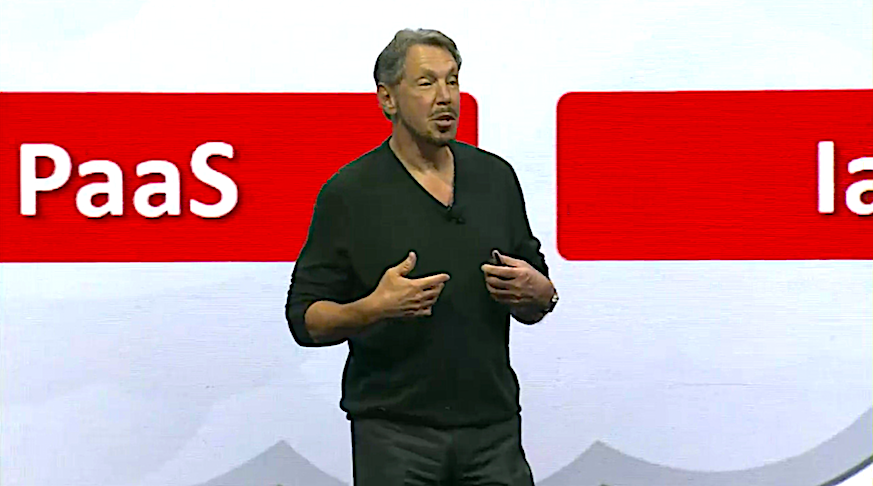 CLOUD
CLOUD
 CLOUD
CLOUD
 CLOUD
CLOUD
Updated:
Oracle Corp.’s come-from-behind battle to join the big leagues of cloud computing got another small boost today, but it wasn’t nearly enough for investors hoping for a faster ascent to the technology industry’s most sweeping trend.
The database and business software giant, which has been in a multiyear transition from licensed software installed in data centers to hosting software in its own cloud data centers, reported that revenue from cloud operations overall jumped 32 percent, to $1.57 billion, in its fiscal third quarter. Still, that came in a hair short of analysts’ average forecast of $1.59 billion.
It may not have been much of a shortfall, but investors hammered the shares Friday, as the stock ended up 9.4 percent lower on the day, the worst one-day performance since 2013. It was a continuation of a pattern set in each of the past two quarters as Oracle’s outlook, especially for its cloud business, came in lower than analysts had expected. In regular trading today, shares were down about 0.6 percent, to $51.95 apiece. Still, that’s not far off from the all-time high of $52.97 that it hit earlier this month.
“Given how important cloud is to Oracle’s future and the fact that the company’s overall share of the cloud market is minuscule compared to topline players, like AWS, Microsoft, Google and IBM, investors’ cautious concerns seem justified,” Charles King, president and principal analyst at Pund-IT Inc., told SiliconANGLE.
Three months ago, the company had forecast cloud growth far short of what analysts had expected. Chairman and Chief Technology Officer Larry Ellison (pictured) cited difficulties in connecting Oracle’s new Cloud Machine and related software installed in customers’ data centers to Oracle’s data centers because of differences among those data centers. Although Ellison didn’t mention that this time, clearly it’s taking awhile for Oracle’s big cloud ambitions to boost the top line significantly.
Overall, Oracle earned a profit before certain costs such as those stemming from the 2017 tax act of 83 cents a share, up 20 percent from a year ago. That easily beat the 72-cent adjusted profit expected by analysts on average. The company posted a net loss of $4 billion, or 98 cents a share, however, thanks to a onetime $6.9 billion income-tax charge related to the tax act.
Revenue rose 6 percent, to $9.77 billion, just a tad shy of analysts forecasts of $9.78 billion, according to a poll by FactSet.
Co-Chief Executive Safra Catz said on the earnings conference call that the company expects overall revenue in the current quarter to rise 1 to 3 percent, with an adjusted profit per share of 92 to 95 cents, or 89 to 92 cents in constant currency. She said cloud revenue would be up 19 to 23 percent, or 17 to 21 percent in constant currency, a slowdown from the third quarter that would be a disappointment.
Traditional on-premises software brought in the vast majority of revenue in the quarter, at $6.4 billion, up 4 percent. But the portion from new software licenses fell 2 percent, to $1.4 billion, making growth in cloud revenue crucial.
Because Oracle had a late start behind the likes of Amazon Web Services Inc., Google LLC and Microsoft Corp. in infrastructure as a service or IaaS, the base-level computing, storage and networking services, the company has focused more on higher layers of the software “stack.”
Software-as-a-service applications such as those offered by Salesforce.com and Workday Inc. rose 33 percent, to $1.15 billion. That’s still well behind rivals’ growth rates, but co-CEO Mark Hurd said in prepared remarks that Oracle’s combined enterprise resource planning and human capital management SaaS services jumped 65 percent in the quarter.
“As the other 85 percent of our applications customers start to move their applications to the Cloud, we have a huge opportunity in front of us,” Hurd said. “We expect to double the size of our SaaS business very quickly.”
Platform-as-a-service software such as Oracle’s own database as well as analytics and application management, combined with IaaS, rose 28 percent, to $415 million. But the reporting of those two categories together only underscores how far Oracle trails behind AWS and others in IaaS.
“It feels like they are in a good position migrating and maintaining their customer base,” said Ralph Finos, an analyst with Wikibon, owned by the same company as SiliconANGLE. “But I think it will be a longish grind because of the complexity. The traditional on-prem folks are just going to have to take longer.”
The company’s spending is under a microscope as well. Last month, Oracle announced plans for 12 new data center regions worldwide for its cloud platform as rivals AWS, Google and Microsoft spend billions to expand their own cloud operations. Deutsche Bank analyst Karl Keirstead last month hiked his estimate of Oracle’s capital spending in the next fiscal year from 2 percent to 8 percent, totaling $2.16 billion.
THANK YOU